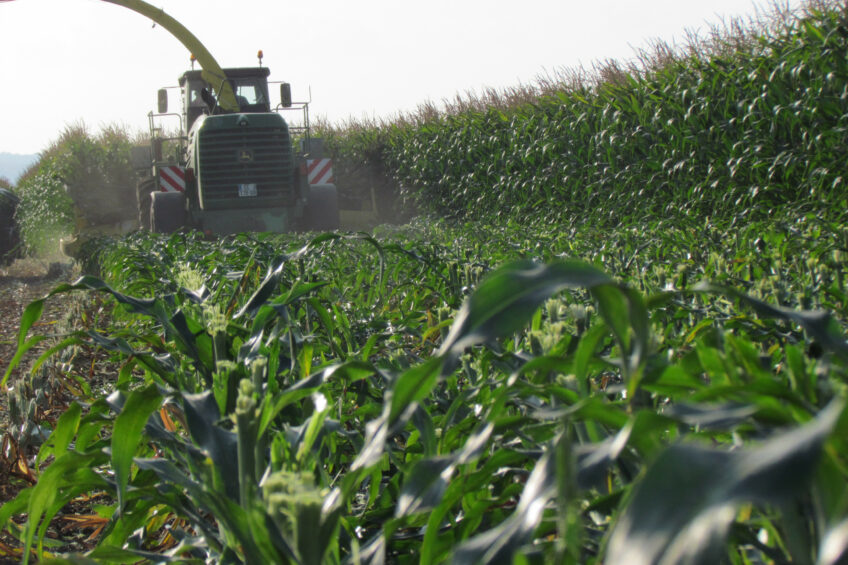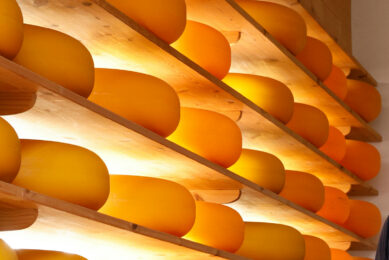The effect of maize cutting height on cows

By increasing the maize cutting height to 30-40 cm compared to the classic height of 15 cm could lead to forage with a higher dry matter digestibility. This can be beneficial for feeding high producing cows.
The forage team of ARVALIS-Institut du végétal, a French applied research Institute, studied the maize cutting height and its effect on digestibility in further detail.
Such information is useful for dairy farmers and maize breeders to optimise the application of the crop even further. In the study, five maize hybrids were grown in two locations in France (Western and Eastern region). The mean plant height was 224 cm +/-20 cm and cob insertion height was 99 +/-9 cm. To get full data of the yield and the chemical composition of lower stover sections, maize plants were cut down at ground level (=0 cm) and sliced into five stover sections: 0-15 cm; 15-35 cm; 35-55 cm; 55-75 cm and above 75 cm (section containing the cob).
Effect of higher cutting height
The results revealed that between 0 and 75 cm above ground level, DM yield was very stable with 36+/- 6 kg DM/cm/ha. This figure is a bit lower than the international reference set at 45 kg/cm/ha (Wu and Roth, 2003). Raising the cutting height from 15 cm to 55 cm increased starch content by 100 g/kg (Table 1). The proportion of the stalk, with high fibre content, decreases as the NDF content falls by 70 g/kg. Raising the cutting height from 15 cm to 55 cm concentrates the harvested forage in ears which permits to increase DM content by 20 or 30 g/kg to reach the optimal stage more quickly and avoid leakage in the silo bunker. Rumen degradabilities of the stover sections (up to 15 cm) were obtained by an in sacco trial lead at ARVALIS experimental farm. Whereas DM effective degradabilities were very stable for sections under 75 cm, they were much lower than the section above 75 cm containing the cob. Thus the predicted organic matter digestibility increased from an average of 0.497 for stover sections 15-75 cm to 0.752 for sections above 75 cm. The ’55 cm maize forage’ is subjected to increase the acidosis risks slightly due to its high and quick DM degradability in the rumen (+3%). For the five maize hybrids cut at 55 cm, the organic matter digestibility is increased by 2.2 compared to those cut at 15 cm. This better digestibility improves net energy for lactation by 4% and increases forage ingestibility. The protein value protein is also improved due to a higher crude protein content and organic matter fermented in the rumen.
Standardisation of forage quality
Adjusting the maize cutting height permits to modify the composition and nutritive value to reduce the variability of maize silage quality in the bunker over the different fields or over the years of harvest. With this technique it is possible to increase the DM content of the harvested forage by 0.7% for every 10 cm of stover let at field. Thus, it can be possible to anticipate by 5 to 15 days a harvest depending on the maize desiccation (from 0.2 to 1% of DM per day during the grain filling). If the maize DM content is over 35-36%, it is not recommended to harvest the forage at 55 cm height; it would be rather better to harvest it a bit later as snaplage (silage which includes the grain, cob, and shuck silage) and adjust a diet with a high inclusion of grass to reach a minimum NDF content of 22% and a high milk production.
Change in diet formulation
Consequences of raising maize cutting height on ration formulation (INRATION 3.22 software) and farm main surface area have been observed by replacing the classical ‘15 cm maize silage’ by a ‘55 cm maize silage’ in a dairy cow diet (fat corrected milk yield: 35 kg/day) based on maize silage, grass silage, wheat grain and soya meal. This substitution leads to increase the forage:concentrate ratio by on average 5 % for diets aiming to maximise grass and maize intake (Table 2) without affecting NDF diet level nor milk quality. Due to a lower crop yield with a high cut, maize forage area needs to be extended by 10 to 25%. The main forage area (MFA) tends to be higher when a ‘55 cm maize silage’ is used in the two diet formulations tested maximising maize or grass intake. In case a simple substitution of a ‘15 cm maize’ by a ‘55 cm maize’, US studies showed that the milk production increased by 1.4 kg/d but fat content decreased by 3 g/kg.
Conclusions
Raising maize whole plant cutting height allows getting a better nutritive value for the harvested forage but penalize a bit the DM yield per hectare. The adjustment of the height cut could be an effective mean to modify the forage chemical composition to reach more easily the quality required depending on the cattle needs. The use of high cut maize silage is efficient to level up the proportion of forage in the ration formulation but need to extend the farm main forage area.
Join 13,000+ subscribers
Subscribe to our newsletter to stay updated about all the need-to-know content in the dairy sector, two times a week.










